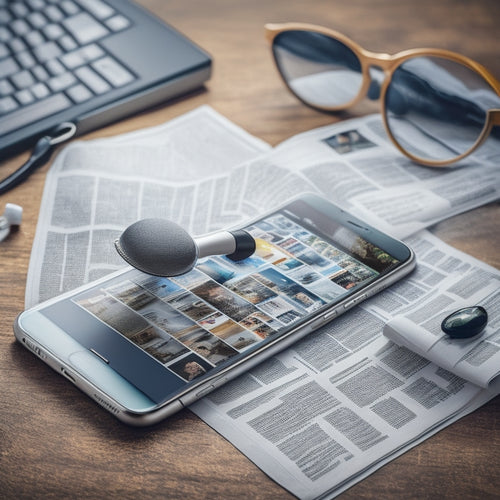
How Do You Look at Mirrors While Driving?
Share
You check your mirrors while driving by maintaining a consistent routine of glances every 5-10 seconds, ensuring you're aware of your surroundings and minimizing blind spots. Properly adjust your mirrors to center on the rear window and capture adjacent lanes. Develop a habit of checking your mirrors frequently to stay informed about traffic behind and around you. By doing so, you'll increase blind spot awareness and reduce accidents. As you master the art of mirror checking, you'll discover the importance of proper mirror placement and how it affects your overall safety on the road.
Key Takeaways
• Adjust your rearview and side mirrors to minimize blind spots and ensure a clear view of the road behind and beside you.
• Check your mirrors every 5-10 seconds to stay informed about traffic behind and around you.
• Take brief, fleeting glances (about 1-2 seconds) to assess your surroundings while staying focused on the road ahead.
• Properly position your mirrors to capture adjacent lanes and reduce blind spots.
• Regularly checking your mirrors helps you anticipate and respond to road conditions, reducing the risk of accidents.
Adjusting Your Mirror Setup
Set your mirrors to minimize blind spots by adjusting the rearview mirror to center on the rear window. The side mirrors should be positioned to capture the lanes adjacent to yours. This mirror placement guarantees you've got a clear view of the road behind and beside you.
Properly adjusted mirrors minimize blind spots, allowing you to stay aware of your surroundings. Take a moment to adjust your mirrors before driving - it's a simple step that can greatly improve your safety on the road.
Developing a Rearview Habit
By consistently checking your mirrors every 5-10 seconds, you'll develop a rearview habit that becomes second nature, allowing you to stay informed about the traffic behind and around you. This habit helps reduce rearview anxiety, making you a more confident and defensive driver.
As you glance at your mirrors, focus on your blind spots, checking for vehicles that may be lurking outside your direct line of sight. By doing so, you'll increase your blind spot awareness, reducing the risk of accidents.
Checking Mirrors Safely While Driving
When checking your mirrors while driving, you'll want to make sure to do so in brief, fleeting glances, taking about one to two seconds to assess your surroundings. This allows you to stay focused on the road ahead while still being aware of your surroundings.
Proper mirror placement is vital, with your rearview mirror positioned for a clear view behind you and your side mirrors adjusted to minimize blind spots.
From a driver psychology perspective, it's important to develop a routine of regularly checking your mirrors to stay alert and aware. By doing so, you'll be better equipped to anticipate and respond to changing road conditions, ensuring a safer drive.
Minimizing Distractions on the Road
One major contributor to accidents on the road is driver distraction, and minimizing it's crucial to guaranteeing your safety and the safety of others.
You can't control other drivers, but you can control your own actions. To minimize distractions, put away your phone and avoid eating or grooming while driving. Keep your eyes on the road and your hands on the wheel.
Good road etiquette demands that you stay focused on the road and avoid multitasking. By maintaining driver attention, you'll reduce your risk of accidents and guarantee a safe journey.
Practicing Effective Mirror Checks
You should check your mirrors every 5-10 seconds to stay aware of your surroundings and maintain a safe following distance. Proper mirror placement is essential for effective mirror checks.
Adjust your mirrors to minimize blind spots, ensuring you have a clear view of the road behind and around you. Position your rearview mirror to capture the entire rear window, and adjust your side mirrors to eliminate blind spots.
By doing so, you'll reduce blind spot areas, allowing you to stay alert and react to potential hazards.
Frequently Asked Questions
Can I Use Mirrors With Tinted or Colored Glass?
As you gaze into the mirror, tinted reflections stare back, altering your colored perceptions. Technically, yes, you can use mirrors with tinted or colored glass, but be aware that they might distort your view, affecting your driving judgment.
How Often Should I Clean My Rearview Mirror?
You should clean your rearview mirror regularly to maintain excellent glass quality, ensuring clear visibility; ideally, wipe it down every week, or whenever you notice streaks or smudges, as part of your routine mirror maintenance.
Do Mirrors With Built-In Displays Distract Drivers?
You're right to wonder if mirrors with built-in displays distract drivers. Research suggests they can, causing driver distraction and visual overload, especially if you're not used to the additional info, compromising your focus on the road.
Can I Attach a GPS to My Rearview Mirror?
"As you navigate the open road, you're wondering if you can attach a GPS to your rearview mirror. The answer is yes, with various mounting options available, including adhesive, suction cup, and clip-on designs, ensuring seamless GPS integration."
Are There Mirrors Specifically Designed for Night Driving?
When driving at night, you'll appreciate mirrors with night vision enhancement, which reduce glare and improve visibility. Look for anti-glare coatings or specialized night-driving mirrors that minimize reflections, ensuring a safer, more comfortable drive.
Related Posts
-

3 Best Online Tools for Organized Dance Makeup Artists
You need online tools to streamline your workflow and deliver exceptional service to your dance clients. For seamless...
-

Get Your Dancing Feet Wedding Sign Now
A custom 'Get Your Dancing Feet' wedding sign is a unique way to reflect your personal style and share your love stor...
-

Newspaper Headline: Access Engaging Social Media Assets Privately
In today's digital landscape, crafting an engaging online presence requires a strategic balance between providing all...


